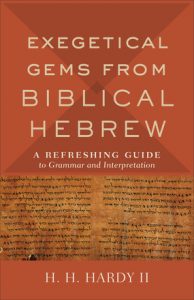Hardy II, H. H. Exegetical Gems from Biblical Hebrew: A Refreshing Guide to Grammar and Interpretation. Grand Rapids, MI: Baker Academic, 2019, pp. 224, $19.99, paperback.
H. H. Hardy is associate professor of Old Testament and Semitic languages at Southeastern Baptist Theological Seminary where he has served since 2014 (back cover). Dr. Hardy earned his PhD at the University of Chicago. Alongside teaching, Dr. Hardy is the author of numerous academic publications.
Hardy wrote Exegetical Gems from Biblical Hebrew to college and seminary students and former students of Hebrew (xiv-xv). The concept of the book developed in response to students questioning the value of learning Biblical Hebrew (xiii). As a resource to college students, the design of the book follows popular Hebrew grammar structures: nouns, adjectives, verbs, particles, and clause structure (xiv). Hardy suggests that Hebrew instructors use this volume as a weekly supplement alongside a Hebrew grammar to motivate student’s desires to learn Hebrew (xv).
The thirty chapters are roughly organized the same. Each chapter receives an introduction, overview, interpretation, and recommendations for further reading. The numerous chapters make listing each chapter cumbersome, but students of Hebrew will have a rough layout in mind from previous studies. The book’s first three chapters address the Hebrew language and literature, textual criticism, and word studies before entering into the grammar. Pronouns and prepositions receive two chapters each, verbs receive twelve chapters, and the remaining eleven chapters cover topics such as definiteness, the directive Heh, interrogatives, and clauses. The book includes a scripture index that students and pastors will find helpful when looking for specific Scripture helps.
The grammar surveys a sampling from the entire Hebrew Bible. The reader will notice text selections from the Torah, the Neviʾim, and Ketuvim (the Law, the Prophets, and the Writings). Each chapter generally examines a single verse from the Hebrew Bible, but some chapters introduced multiple verses and a single chapter with three verses. The author, at times, splits verses, but on each occasion, the author worked on the other half of the verse in the following chapter.
The book fulfills the promises held with its title and meets the objectives set by the author. The book proves to be a supplement for Hebrew grammar, and the ‘gems’ within the book can motivate students. The author accurately writes to his target audience of current and former students of Biblical Hebrew and professors using the book as a teaching aid.
The book shows the need to learn Hebrew. Each ‘gem’ highlighted in the book is a verse that is difficult to interpret without understanding Hebrew. In some cases, the author disagrees with the translators of popular English translations. However, Hardy is not using this book as a platform to set matters straight. The reader will notice that Hardy provides interpretations that also agree with English translations, and that Hardy provides conclusions for pedagogical purposes.
The book has characteristics in common with intermediate grammars, but the book is better thought of as a bridge between an introductory grammar and intermediate grammar. These intermediate features are, perhaps, the most attractive component of the book and are most prominent in chapters 9, 10, and 12. While these chapters focus on the Hebrew verb, they also discuss clausal syntax, a topic not often discussed in detail in introductory grammars. Hardy introduces instructors and readers to narrative analysis, mainline and offline, and relationships between clauses.
Exegetical Gems from Biblical Hebrew has two stumbling blocks to instructors and readers using the book. First, the book introduces weak verbs early. An early introduction of weak verbs exposes the fact that the book does not perfectly align with introductory grammar books. For instance, introductory grammars often teach stative and fientive verbs alongside the Qal Perfect, which is often the first verb form taught in introductory grammars. Hardy includes stative and fientive verbs in the eighth chapter on verbs in chapter 17 (105). Second, Hardy’s assumption of the student’s knowledge may be too much in some instances. For example, the author assumes some textual critical methods are known to the reader in chapter two (9). Also, not all introductory grammars include vocabulary such as transitive and intransitive, which places a burden on the reader who is unfamiliar with these terms (107).
The reader can overcome the difference in order and the author’s assumption of previous knowledge through a professor’s instruction. However, the reader whose Biblical Hebrew is rusty may find themselves digging up their grammars or running to the library for additional resources to obtain fuller explanations. However, Hardy has included enough information for any reader to utilize and benefit from this book. The chapters include helpful summaries or refreshers of previous material such as a table for derived stems, “Grammatical Categories of Derived Stems” (119). In several instances, Hardy’s summaries present information through a set of fresh eyes.
A fresh presentation of information, the ‘gems,’ and the intermediate grammar material will motivate students. By providing previously learned material to students in an alternative manner, previous material may become clearer and may finally ‘stick’ for some students. The ‘gems’ in the book do demonstrate to students the value of learning Hebrew. Every example assists in interpreting the text and will translate into a better understanding of God’s Word and better preaching. Finally, intermediate grammar material gives students crucial tools for interpreting Biblical Hebrew. Introductory grammars often leave the student working at the sentence level. Leaving students at the sentence level creates difficulty interpreting passages of the Hebrew Bible. Providing a few examples of clausal syntax will allow students to translate Hebrew better.
Exegetical Gems from Biblical Hebrew is recommended both to professors of Biblical Hebrew and students of Biblical Hebrew. The book provides helpful grammatical summaries and presents new information close to an intermediate grammar. The verse selection and analysis will surely motivate students to continue their desire to learn the original language of the Old Testament.
Ross D. Harmon
Midwestern Baptist Theological Seminary





